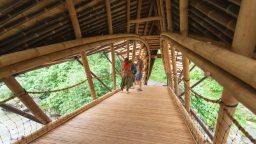As one of the most versatile materials on the Earth, there are a plethora of uses and benefits of limestone. It can be utilized for a vast number of activities from fertilizing lawns to whitening teeth. Discover more on how limestone works to benefit your livelihood.
Gardening and Farming
Limestone has the capability of adjusting the acid levels in the soil to produce conditions that are ideal for growing crops on both the larger agricultural scale and in smaller home gardens. Plants, vegetables, and other crops are protected from nutrients in the ground that could potentially become toxic from nutrients being too prevalent like aluminum. It keeps the pH level at about 5.6 when applied properly. Anything over 5.5 is best for plant and food growth. It also adds minerals that are valuable for the soil like calcium and magnesium.
Building Material
The use of limestone in building goes back centuries. From the time the building of the Megalithic Temples that are the oldest free-standing structures through the construction of The Great Pyramid of Giza and beyond, people have been adding limestone to their creations. Train stations and banks from the Victorian era and after the 20th century have limestone in them. Today, exteriors and tiles are often made up of travertine, which is a form of limestone. The only problem with the material is that it is damaged when it comes in contact with acid solutions like acid rain.
Golf Courses
The pH balance in the soil on golf course greens is something that lawns keepers keep a close eye on to ensure they produce the best results. Not only does the proper pH look nicer, but it also makes it easier for players. When the turf gets out of the ideal range, limestone can be applied to the dirt to regulate the levels.
Lawn Growth
When lawns aren’t growing in as full and thick as you want them to, limestone in a pulverized form can be applied to change that. It improves the structure of the soil which makes for a better growing condition for the grass. You should apply the limestone before planting grass for an evener distribution and possibility for water penetration and absorption for a favorable soil structure.
Cat Litter
There are odor and moisture absorbing properties to limestone that make it useful in kitty litter. Cat urine contains ammonia that can cause respiratory problems when present in large amounts. The lime counteracts the potentially damaging effects of your cat’s litter box making it safer and more pleasant to be around for you and your family.
Healthy Horses
During the colder winter months, farmers and other owners like to keep their horses inside a safe barn to protect them from the elements. The problem arises with the ammonia that comes from the animals urinating in the stalls that they stand in for extended periods of time. When limestone is placed under their bedding in a way that the horses will not have contact with it, it can absorb the ammonia making the barn a safer, better smelling place to be.
Roads
The base of many roads has a crushed limestone component included. Asphalt is made up of limestone in part as well. It continues to be used in the updates of existing highways and urban infrastructures today.
Teeth Whitening and Other Brightening Uses
Inside of your toothpaste, limestone is used as filler and a pigment that helps in cleaning your teeth and making them brighter. It is cheap and can lighten up a plethora of other materials as well, so it’s often put in plastic, paint, tile, and paper for a bigger and brighter finished product.


